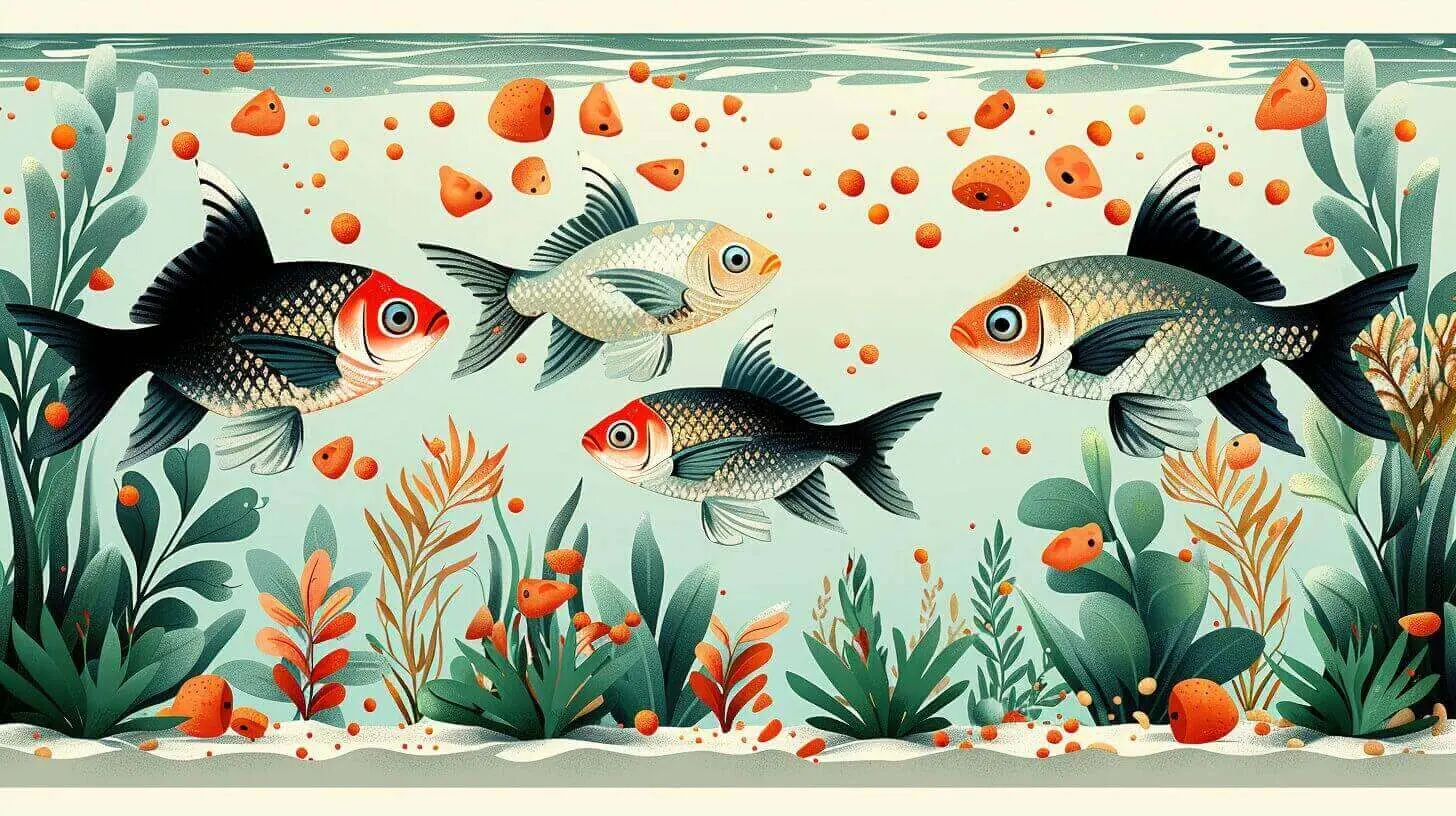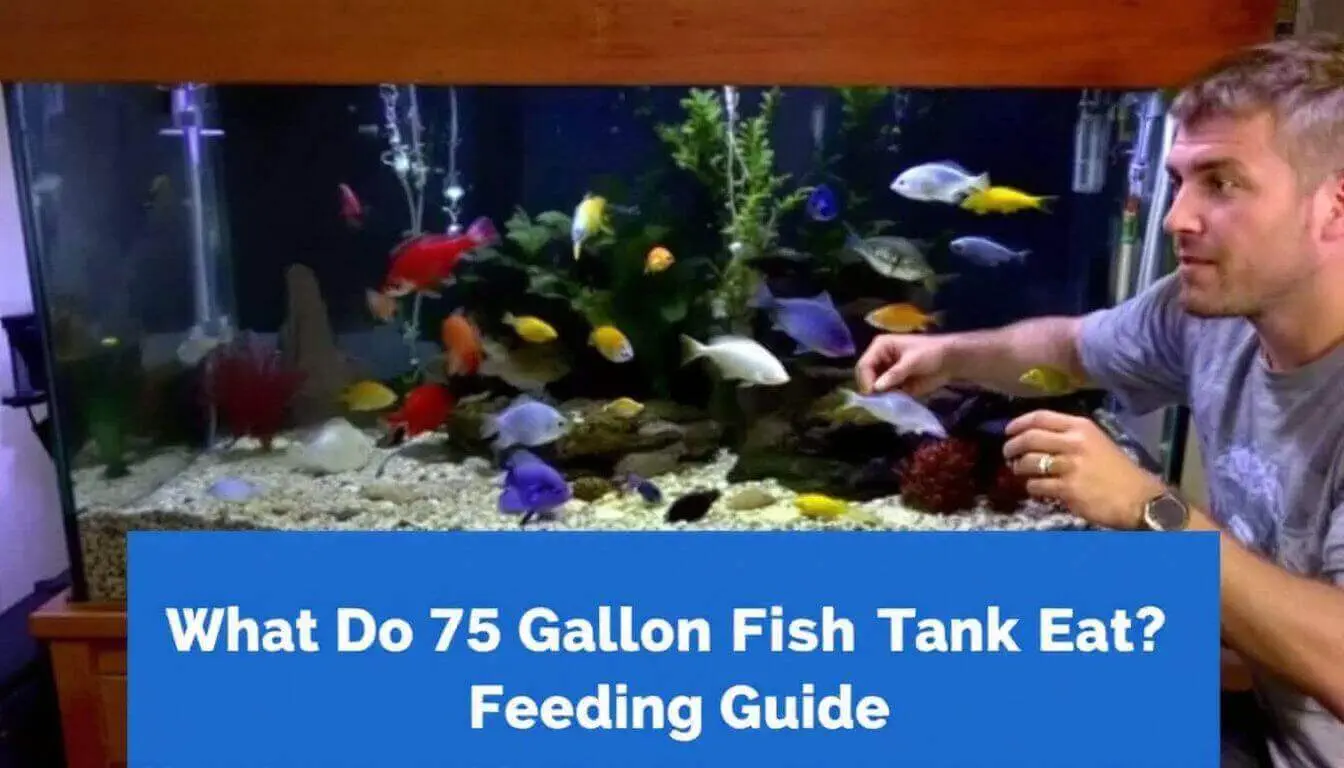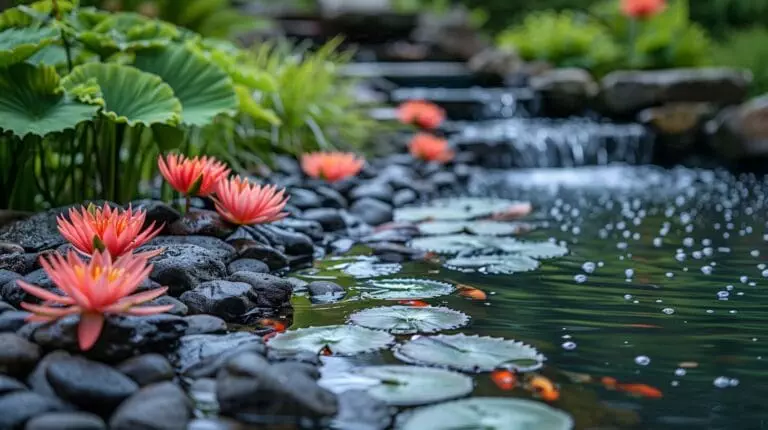Feeding fish in a 75 gallon tank can be tricky. You need to know what each fish likes to eat. Different fish have different diets. Some eat plants, while others prefer meat. 2 Getting it right keeps your fish healthy and happy.
I’ve kept fish for over 10 years. I’ve learned a lot about what 75 gallon fish tank fish need to thrive. 1 In this guide, you’ll find out how to feed your fish the right way. Ready to become a fish feeding pro?
Key Takeaways
- Fish in a 75-gallon tank need different foods based on their species. Some eat plants, others prefer meat.
- Feed small amounts 1 to 2 times daily. Most fish eat all their food in 5 to 10 minutes.
- Use high-quality flakes or pellets as main foods. Add frozen, freeze-dried, and live foods for variety.
- Stock about 1 inch of fish per gallon of water. This helps prevent overcrowding.
- Clean your tank weekly. Remove 10% to 15% of water and replace it with fresh, treated water.
Choosing the Right Fish for a 75 Gallon Aquarium

Picking fish for your 75-gallon tank is fun and important. You’ll need to think about size, behavior, and how many fish to add.
Best Fish for Your 75 Gallon Tank
Your 75-gallon tank offers space for many fish types. 1 Here are some top choices for your aquarium:
- Electric Blue Jack Dempsey
- Grows up to 7 inches long.
- Needs hiding spots and open swimming areas
- Eats small fish and insects
- Green Spotted Puffer
- Best kept alone due to aggressive nature.
- Requires brackish water
- Enjoys a diet of snails and crustaceans
- Discus
- Keep up to 7 adults in a 75-gallon tank.
- Prefers warm, soft water
- Feeds on bloodworms and brine shrimp
- Boesemani Rainbowfish
- Thrive in groups of up to 15.
- Like planted tanks with open swimming spaces
- Eat flakes, pellets, and live foods
- Blue Emperor Tetras
- Can keep up to 50 in a 75-gallon tank.
- Enjoy schools and planted areas
- Feed on small insects and zooplankton
Compatibility and Schooling Requirements for Fish
Now that you know the best fish for your 75-gallon tank, let’s discuss how they coexist. Fish have different requirements for living with others.
- Separate African Cichlids from peaceful fish. They can be aggressive and harm others. 2
- Rainbowfish thrive in groups. Place 1 male with 2 females to prevent conflicts.
- Discus fish are content in small groups. Up to 7 can thrive in a 75-gallon tank.
- Corydoras prefer company. Acquire 5 to 10 of them for a content school.
- Spotted Blue Eye Rainbowfish enjoy large groups. You can house up to 50 in a 75-gallon tank.
- Pair fish that prefer the same water temperature and pH. This maintains their health.
- Some fish require hiding places. Include plants or rocks for them to feel secure.
- Be aware of fin nippers. They can cause stress to other fish with long fins.
- Provide your fish with appropriate food. Each species needs its own diet to remain healthy.
- Consider if your fish prefer top, middle, or bottom areas. Vary it for an active tank.
How to Select Healthy Fish for Purchase
Look for bright, clear eyes and smooth scales when picking fish. Avoid fish with torn fins, spots, or odd growths. Active fish that swim normally are usually healthy. Check if the store’s tanks are clean and well-kept.
This shows they care for their fish. Ask to see the fish eat before you buy. Healthy fish will be eager for food. Buy from shops that quarantine new fish to prevent disease spread. 3
Choose fish that fit your tank size and setup. Research their adult size and needs. Pick fish that get along with others you have. Start with hardy species if you’re new to the hobby.
Slowly add fish over time, not all at once. This keeps your tank balanced and gives new fish time to settle in.
Feeding Practices for Freshwater Fish in a Community Tank

Feeding your fish right keeps your tank happy. Want to learn more about feeding your finned friends?
Guidelines for Feeding Different Fish Species
Fish in your 75-gallon tank need proper food to stay healthy. Here are key guidelines for feeding different fish species:
- Feed small amounts 1 to 2 times daily. Most fish eat all their food in 2 to 3 minutes. 4
- Give herbivores like plecos more frequent, smaller meals. Their small stomachs need regular refills.
- Offer young fish and fry 3 to 4 small meals per day. They grow fast and need extra fuel.
- Match food type to each species’ natural diet. Bottom feeders enjoy sinking pellets or wafers.
- Vary the menu with frozen, freeze-dried, and live foods. This ensures balanced nutrition.
- Use high-quality flakes or pellets as staple foods. They contain vital nutrients fish need.
- Adjust portion sizes based on how quickly fish eat. Uneaten food fouls water quality.
- Target feed shy species to make sure they get enough. Use feeding tubes or tongs if needed.
Using Quality Fish Food for Optimal Growth
Quality fish food is key for your aquarium pets to thrive. Pick foods that match your fish’s natural diet. Flakes, pellets, and frozen options offer balanced nutrition. Mix it up to give your fish variety. This keeps them healthy and active. 9
Stick to a feeding schedule. Most fish do well with two small meals a day. Watch how much you give. Uneaten food can dirty the water fast. Clean water means happy, growing fish. Next, let’s look at how to keep an eye on your fish’s eating habits.
How to Monitor Fish Feeding Habits
After choosing quality fish food, you need to watch how your fish eat. Keep an eye on your tank during feeding time. Drop in small amounts of food. See how fast your fish gobble it up. Most fish should eat all their food in 2 to 3 minutes. 5
Look for leftover food at the bottom of the tank. If you see a lot, you’re giving too much. Scoop out any uneaten bits after 5 minutes. This stops the water from getting dirty. Check for cloudy water or extra algae growth too.
These can mean you’re overfeeding. Adjust the amount of food until you find the right balance for your fish.
Understanding Fish Stocking Levels in a 75 Gallon Tank

Keeping the right number of fish in your 75-gallon tank is key. Too many fish can lead to problems, while too few might leave your tank looking empty.
Ideal Stocking Density for a Healthy Fish Community
A 75-gallon tank offers plenty of space for a diverse fish community. You can stock it with 10 platies, 6 zebra danios, 6 corydoras, and 6 otocinclus as small fish. For larger species, add pairs of dwarf gouramis, pearl gouramis, and angelfish.
Choose smaller angelfish to let them grow into the tank. This mix creates a balanced ecosystem with different fish sizes and behaviors. A common rule of thumb is to keep 1 inch of fish per gallon of water. However, it is recommended a more conservative approach of 1 inch of fish per 2 gallons of water.
Your tank’s health depends on proper stocking levels. Overcrowding leads to poor water quality and stressed fish. Aim for about 1 inch of fish per gallon of water. Count only adult fish sizes in this rule.
Regular water tests help you spot issues early. If ammonia or nitrite levels rise, you may need to reduce your fish count or upgrade your filtration system.
Recognizing Signs of Overcrowding in Your Aquarium
Overcrowded tanks spell trouble for fish. Watch for frequent fights and cramped swimming space. These signs mean your aquarium is too full. Fish need room to move freely and establish territories.
Poor water quality is another red flag. Test your water often. If it gets dirty fast, you may have too many fish. Look for stressed fish behavior too. Odd swimming patterns or rubbing against surfaces can mean overcrowding.
Your fish may gasp at the surface for air. This happens when oxygen levels drop in packed tanks. Keep an eye on growth rates as well. Stunted fish could indicate not enough space to thrive. 6
Adjusting Stocking Levels for Different Fish Types
Different fish types need different space in your 75-gallon tank. Big cichlids like Jack Dempseys need more room than small tetras. You’ll want to give each fish enough space to swim and hide.
For example, you might fit 20 neon tetras but only 2 to 3 larger cichlids. Observe your fish. If they seem stressed or fight a lot, you may have too many. It’s better to have fewer fish that are happy and healthy.
Stocking levels also depend on your filter. A strong filter like the Fluval 407 can handle more fish. But don’t push it too far. Overstocking leads to poor water quality fast.
Start with a few fish and add slowly. This gives your tank time to adjust. It also lets you see how your fish get along. A fully cycled tank is essential before adding any fish.
Best Practices for Feeding and Caring for Your Fish

Feeding your fish right keeps them healthy and happy. Regular tank cleaning and water changes are key to a thriving aquarium.
Importance of Regular Maintenance for Tank Health
Regular tank upkeep keeps your fish healthy and happy. Clean your 75-gallon tank every week. Remove 10% to 15% of the water and replace it with fresh, treated water. This gets rid of waste and keeps nitrate levels low. 7 Scrub algae off the glass and decorations. Check your filter and clean it if needed. 7
Test your water often to catch problems early. Use a test kit to check pH, ammonia, nitrite, and nitrate levels. Adjust as needed to keep the water safe for your fish. Trim any overgrown plants and remove dead leaves. These simple steps will help your fish thrive in their home. 8
Future Considerations for Your Aquarium Fish Journey
As you maintain your tank, think about your future fish goals. You might want to add new species or grow your current fish family. Plan for these changes now. Make sure your tank can handle more fish. Learn about different fish types and their needs.
Stay up-to-date on fish care tips. New foods and tools come out often. These can help your fish thrive. You may also want to try breeding fish. This needs special set-ups and knowledge.
Keep learning and growing as a fish keeper. Your 75-gallon tank offers many exciting options for your aquatic pets. 5
Conclusion
Feeding your 75-gallon tank fish right keeps them healthy and happy. Pick foods that match each fish’s needs. Offer a mix of flakes, pellets, and live treats. Watch how much you give – overfeeding can harm water quality.
With good care, your fish will thrive and bring joy for years to come.
FAQs
1. What do freshwater angelfish eat in a 75-gallon tank?
Angelfish love small live foods… think brine shrimp or bloodworms. They also enjoy flakes, pellets, and frozen foods. Feed them 1 to 2 times daily, but only what they can eat in 2 to 3 minutes.
2. How often should I feed South American cichlids in my home aquarium?
These fish are hearty eaters! Offer them a mix of meaty foods and veggies every day. Some like pellets, others prefer frozen foods. Watch their behavior – they’ll let you know when they’re hungry. Be sure to include variety in their meals to keep them healthy and engaged. The freshwater pufferfish diet should also incorporate live or freeze-dried options like bloodworms or brine shrimp for added nutrition. Remember to avoid overfeeding, as maintaining water quality is essential for their overall well-being.
3. What’s the best diet for a Jack Dempsey fish in a large freshwater tank?
Jack Dempseys are carnivores so they need protein-rich foods. Give them pellets made for cichlids, plus some frozen or live foods like worms or small fish. Feed adults once a day, juveniles more often.
4. Can I keep bettas with other fish in a 75-gallon tank, and what do they eat?
Bettas can live with peaceful tank mates in a big tank. They love small, meaty foods – try betta pellets, frozen bloodworms, or live brine shrimp. Feed them small amounts twice daily.
5. What’s a good feeding schedule for white cloud mountain minnows?
These little guys are easy! Feed them small amounts 2-3 times a day. They like flakes, tiny pellets, and frozen foods. Don’t overfeed – they’re quick eaters but have small stomachs.
6. How do I feed a diverse community in a 75-gallon freshwater aquarium?
Mix it up! Use quality flakes or pellets as a base. Add frozen or live foods for variety. Feed small amounts 1 to 2 times daily. Watch your fish – make sure everyone gets their share. Remember, some fish eat at the top, others at the bottom.
References
- ^ https://light.fish/blog/best-fish-for-75-gallon-aquarium (2024-02-17)
- ^ http://www.habitattitude.net/my-interest/aquarium-fish/choosing-the-species/
- ^ https://www.liveaquaria.com/article/159/?aid=159
- ^ https://www.thesprucepets.com/how-much-should-i-feed-my-fish-1378746 (2024-09-19)
- ^ https://www.aqueon.com/articles/how-to-properly-feed-your-fish
- ^ https://www.aquariumpharm.com/overcrowded-fish-tank/
- ^ https://livingartaquatics.com/aquarium-maintenance-service-guide/
- ^ https://wagwalking.com/wellness/how-to-care-for-fish-a-complete-guide (2023-03-23)



